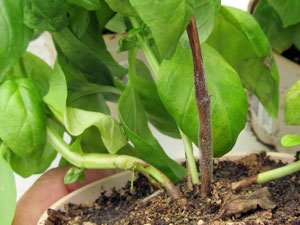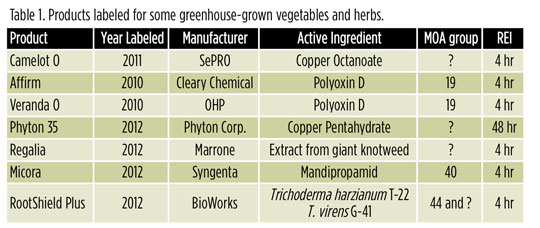9/26/2012
New Fungicides & Bactericides for Vegetables & Herbs
A.R. Chase
A few months ago I was asked to present an update of the new fungicides and bactericides at a grower meeting in Oklahoma. I started to check and see what had been registered over the past three years and was surprised to see how many products had been added to our arsenal in that time. One thing became clear: we’re finally getting some products labeled for use on greenhouse-grown vegetables and herbs. Since ornamental producers are frequently trying to expand their markets, labeling on vegetables and herbs is of great interest. Some of the products are even OMRI listed and can become a part of an organic program. These include RootShield Plus, Camelot O and Regalia.
Table 1 lists the products that are most recently labeled for use on greenhouse vegetables and herbs. Most of these products are registered with a 4-hour REI, making them very user-friendly. They’re quite variable in their activity range, from relatively narrow like Micora (Phytophthora and downy mildew only) to Camelot O, which can be effective on many foliar diseases including bacterial diseases.
Bot rytis stem rot on herbs can be common, like on this basil plant. There are many fungicides and bactericides that have been recently registered for use on vegetables and herbs.
rytis stem rot on herbs can be common, like on this basil plant. There are many fungicides and bactericides that have been recently registered for use on vegetables and herbs.
Camelot O is an organic copper that is widely registered for many bacterial and fungal diseases and has a 4-hour REI. In two trials we performed a few years ago, Camelot O performed as well as Camelot. We tested it against Alternaria leaf spot on impatiens and Xanthomonas leaf spot on geraniums. Be sure to use correct label rates as this is not a direct replacement for Camelot—rates are higher on Camelot O.
The other new label on a copper product is Phyton 35. This is copper pentahydrate like Phyton 27, but can be used on ornamentals and vegetables. Phyton 35 doesn’t have an OMRI listing and has a 48-hour REI, which may limit its use. The changes made to inert ingredients have allowed a “warning” label compared to the “danger” label of Phyton 27.
Affirm (Cleary Chemical) and Veranda O (OHP) were each registered for use in our markets in 2010. They’re equivalent products containing polyoxin D. This MOA 19 active ingredient was first formulated in Endorse. Its activity is very good on a number of diseases including Rhizoctonia, rust, powdery mildew, leaf spots (like Cylindrocladium on myrtle) and black root rot. It’s actually almost as effective as thiophanate methyl for black root rot and a good rotation partner to a thiophanate methyl fungicide like OHP-6672 or 3336.
Micora is a new active ingredient (mandipropamid), but is in the same MOA group as Stature, which is MOA 40. It’s been very safe in all of the trials I’ve performed or reviewed and it’s very effective against downy mildew pathogens and Phytophthora. Use sites include: “greenhouse and outdoor ornamentals, and listed vegetables (a few herbs listed) grown for transplant and retail sale to consumers.” Micora is a great choice for basil downy mildew. Micora is not yet registered in California. (If you’re in California, Syngenta registered the same active ingredient as Revus on a 24c—an exception to the federal pesticide law for Special Local Use.)

Regalia is an OMRI-listed product that I’ve worked on occasionally over the past almost 20 years. It’s been reformulated and finally brought to market by Marrone Bio Innovations and is labeled for just about anything you want. It’s primarily marketed as “a plant extract to boost the plant’s natural defense mechanisms to protect against certain fungal and bacterial diseases, and to improve plant health.” It has a 4-hour REI. In our trials with Regalia alone, we’ve seen some to very good control of bacteria and fungal leaf spots and powdery mildew; however, it’s to be primarily used as a tank-mix partner with other bactericides or fungicides according to the label.
RootShield Plus is the newest product from BioWorks. It does have OMRI listing and a broader range of activity than RootShield. The new product is a combination of
Trichoderma harzianum T-22 and
Trichoderma virens G41. It’s somewhat variable in its efficacy, which is a characteristic of biological control agents. It’s labeled for Pythium, Phytophthora, Fusarium and Rhizoctonia root diseases.
Heritage has also seen some label modifications over the past couple of years to include more herbs, vegetables and fruit. In some states, Syngenta has acquired a 24c for basil downy mildew as well. The most current label I examined says, “Heritage may be applied to plants used for food in production nurseries, gardens and landscapes to control certain diseases. Follow the pre-harvest interval following applications prior to consuming fruits, nuts or other produce from those treated areas.”
Conclusions
We do finally have quite a few legal choices now for control of some diseases on greenhouse and nursery-grown vegetables and herbs. In some cases, the products are even labeled for organic production, allowing us to reach this specialized consumer market. As always—be sure to follow labels carefully and contact your state university specialist, distributor rep or manufacturer of the product if you have any questions.
GT
A. R. Chase is owner of Chase Agricultural Consulting, LLC based in Cottonwood, Arizona. She can be reached at archase@chaseresearch.net.